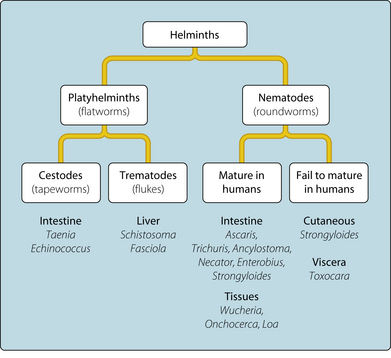6. Helminths
the basic facts
Human helminth diseases occur worldwide but are most prevalent in countries with poor socioeconomic development. They seldom cause acute disease but produce chronic infections that can have a severely debilitating effect on the host (Ch. 34).
Parasitic helminths comprise the nematodes (roundworms, filaria), cestodes (tapeworms) and trematodes (flukes) (Fig. 3.6.1).
Nematodes
The nematodes are typically worm-like in appearance (Fig. 3.6.2). The intestinal pathogenic nematodes may be divided into two groups.
Those that develop in soil, the larvae being the infectious stage.The larvae are shed in the faeces and mature in the soil. They infect humans by burrowing into the skin (usually through the soles of the feet) and enter the bloodstream to be carried to the heart and lungs. They then force their way into the alveolus and trachea, and, on reaching the epiglottis, are swallowed. The life cycle then continues in the small intestine.
Those that survive in soil, the eggs being infective.The eggs are the infectious form in which the larvae develop. When ingested, the larvae hatch in the small intestine, penetrate the mucosa and are carried through the bloodstream to the heart and lungs. The rest of the life cycle is as described above.
< div class='tao-gold-member'>
Only gold members can continue reading. Log In or Register to continue
Stay updated, free articles. Join our Telegram channel

Full access? Get Clinical Tree










